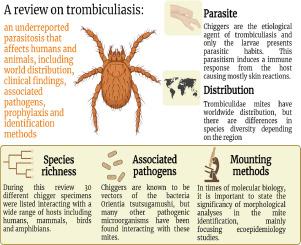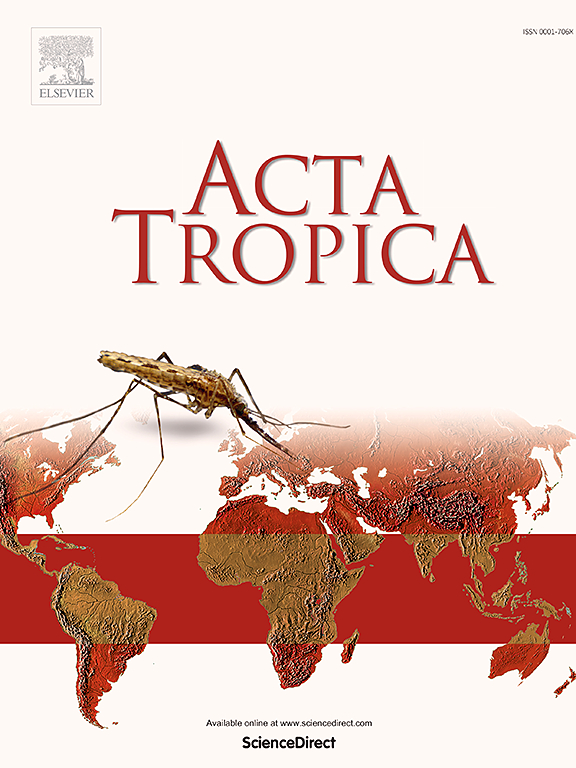A review on trombiculiasis: An underreported parasitosis that affects humans and animals, including world distribution, clinical findings, associated pathogens, prophylaxis and identification methods
IF 2.1
3区 医学
Q2 PARASITOLOGY
引用次数: 0
Abstract
Chigger mites comprise three families: Trombiculidae, Leeuwenhoekiidae and Walchiidae, with over 3,000 species worldwide. Their life cycle includes six stages, and the larvae are parasites, while the other stages are free-living predators. Once attached to a host, the larvae spend several days feeding on the host's epithelial tissue, forming the stylostome. An inflammatory reaction can be formed during larval feeding, known as trombiculiasis or trombiculosis. In this study, we provide a literature review using 123 scientific articles on the cases of trombiculiasis in animals and humans reported in different biogeographical regions, including 29 countries and 30 different chigger species, with all the information compiled in the Supplementary material. This review aims to increase the visibility of this disease and group of mites, so that physicians and veterinarians can become more aware of the disease and include the causative agent in differential diagnoses. We also offer knowledge on mounting and control methods in order to improve mite identification for future research. Lastly, the prophylaxis and control methods in cases of infestations and associated pathogens are mentioned.

关于血吸虫病的综述:一种未得到充分报道的影响人类和动物的寄生虫病,包括世界分布、临床表现、相关病原体、预防措施和鉴别方法。
恙螨由三个科组成:恙螨由三个科组成:Trombiculidae、Leeuwenhoekiidae 和 Walchiidae,在全世界有 3,000 多个物种。它们的生命周期包括七个阶段,幼虫是寄生虫,其他阶段则是自由生活的捕食者。幼虫附着在宿主身上后,会花几天时间在宿主的上皮组织上取食,形成花柱。幼虫取食过程中可能会形成炎症反应,这就是所谓的龙线虫病或龙线虫病。在本研究中,我们利用 123 篇科学文章对不同生物地理区域(包括 29 个国家和 30 种不同的恙虫属)报告的动物和人类曲皮蝇蛆病病例进行了文献综述,所有信息均汇编在补充材料中。本综述旨在提高这种疾病和螨类的知名度,使医生和兽医对这种疾病有更多的了解,并将病原体纳入鉴别诊断中。我们还提供了有关安装和控制方法的知识,以便为今后的研究改进螨虫鉴定。最后,我们还提到了虫害和相关病原体的预防和控制方法。
本文章由计算机程序翻译,如有差异,请以英文原文为准。
求助全文
约1分钟内获得全文
求助全文
来源期刊

Acta tropica
医学-寄生虫学
CiteScore
5.40
自引率
11.10%
发文量
383
审稿时长
37 days
期刊介绍:
Acta Tropica, is an international journal on infectious diseases that covers public health sciences and biomedical research with particular emphasis on topics relevant to human and animal health in the tropics and the subtropics.
 求助内容:
求助内容: 应助结果提醒方式:
应助结果提醒方式:


